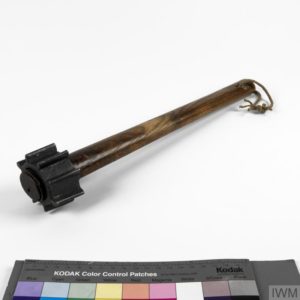Sunday May 26th, 1918
Mail up – two letters from home. Sorry to hear Abram Sutton has been called up – hard lines. Day work 7am – 11am. Wrote home. Fighting patrol (22 men) sought for Johnny’s patrol – very moonlit. Goldies 1. Return by Dorkley village, laid up 1 hour – nothing doing. Trap ravine & orchard. Returned 1:10am after five hours. Tired.
Fighting Patrol
According to the manual ‘Scouting & Patrolling’, a night patrol goes out for information, for protection or ‘to kill, capture or harass the enemy’. Tonight Frank goes out in a patrol of 22 men, to achieve the last of these objectives.
The manual has further instructions for the fighting patrol: ‘Patrols sent out to fight should not, as a rule, be sent out until previous reconnaissance has discovered the habits and movement of the enemy. If a Patrol is sent out to bomb sentry posts, it should be as small as the circumstances allow: five men may be regarded as a normal Patrol for this purpose. For engaging the enemy in the open larger numbers (from 8 to 20) may be required. It is difficult for a larger patrol to move undetected. The best method, therefore, is to take up a good position and lie up for the enemy in some suitable formation. Precautions should always be taken against the enemy working round the flanks. A Lewis gun is often useful.’¹
It also has some other useful tips:
-
- ‘The whole Patrol should not be moving at the same time; at least one man should always be listening.’
- The Patrol should be motionless the moment a flare goes up. The best time to move is when it has just gone out.
- A Patrol is as easily seen and ambushed when returning as when going out. The return journey, therefore, should be made with caution and by a different route.
- All concerned must be notified of the place and time of the departure and return of the Patrol.

A knobkerrie, made by RE workshop, 1915-18 Copyright: © IWM (WEA 2134)* - Men on patrol should be lightly equipped. A cap-comforter is least visible, the face and hands should be darkened and gloves may be worn. Each man should carry two bombs a bayonet or knobkerrie, and a revolver or rifle. A revolver is more convenient but men so armed must be expert in its use. The rifle is the best weapon for purposes of protection.
- Scouts going out on patrol should have nothing on them which would assist the enemy if they were captured. They should be instructed how to act if captured. They should be instructed how to act if captured, and informed that prisoners of war are only bound to give their rank, name and number.’²
Frank and his band go out on patrol tonight, it is moonlit, and they don’t encounter any enemy. However, they do lay booby traps for the enemy in both the ravine and the orchard.
Knobkerrie are a combination of club and walking stick, used in Southern and Eastern Africa. During the First World War all armies employed clubs for the purpose of trench raiding. The British trench club in the photograph was made by sliding a special flanged metal head onto the standard entrenching tool handle. The head was designed and produced by the Royal Engineers of Second Army Workshops, from 1915 onwards. They are described in ‘Work of the RE in the European War, 1914-19’ as ‘knobkerries’.*
Bulgars
Ironically, on a night when the fighting patrol encounters no enemy, three Bulgar deserters give themselves up to the sentries on No 2 Post. The BWD also notes that the enemy seems ‘jumpy’. Perhaps the ‘proclamations‘ are working.
13th (Service) Battalion War Diary – 26th May 1918 – Sporan
There was usual slight artillery activity on both sides in the Sector. Our planes were up all day. One enemy plane was observed flying north at 07:30 hrs. At 03:30 hrs 3 Bulgar deserters gave themselves up to No 2 Post on Goldies III. Patrols saw and heard nothing of the enemy. The enemy appears to be somewhat ‘jumpy’ just now, he put up Very lights and throws bombs very often for no reason whatever. There is fresh excavation on Trapeze de Pobreg. Twice during the day men were observed near the dugouts on Devedzelli Spur. No man who is employed in water duties or the handling of food is under any circumstances to be taken also for work with the sanitary squad.
References & Further Reading
¹ ‘Scouting & Patrolling‘ (Issued by the General Staff) December, 1917. ‘Night Patrols’, item 4, page 20
² ibid, ‘Night Patrols’, item 2, points h to l on pages 19 & 20
* A knobkerrie, WEA 2134, copyright Imperial War Museums


